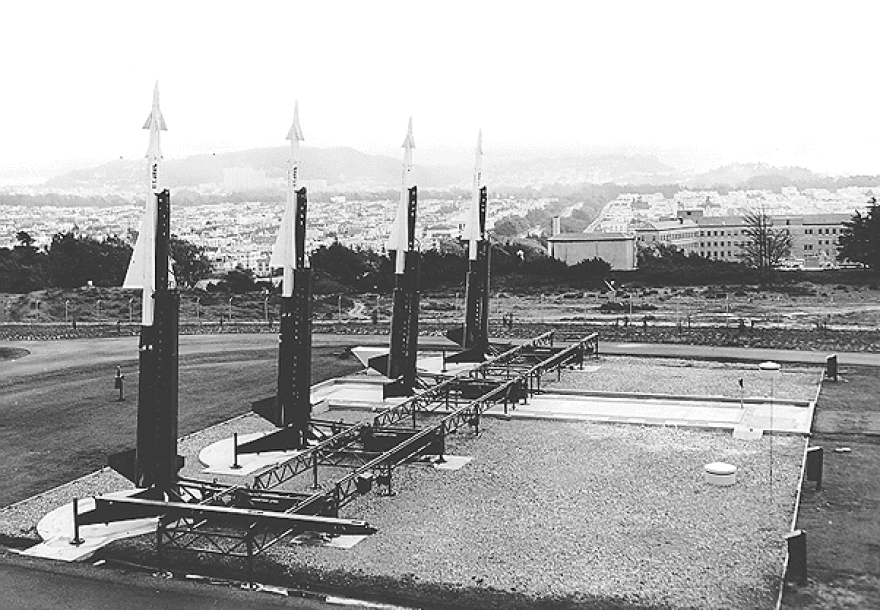The 1950s are seen as a golden age for the U.S., a time when the country was prosperous and the nuclear family reigned supreme. But the nation had another nuclear obsession — a looming, existential threat that seemed imminent, if not guaranteed.
The country was embroiled in a war unlike any it had seen before, a Cold War with the nascent Soviet Union, a superpower fighting for its place on the world stage.
The U.S. feared a nuclear attack. One solution? Project Nike Ajax — an anti-aircraft missile system surrounding every major U.S. city.
WUWM's Bubbler Talk has received a number of questions about these old sites in Wisconsin.
“They were generally clustered around very large cities like Milwaukee and Chicago, and they call them rings of supersonic steel, because they were the ones that would be guarding as a last line of defense from incoming Soviet bombers that we were fearful we're going to use nuclear weapons and blow us up,” explains Chris Sturdevant, chairman of the Midwest Chapter of the Cold War Museum.
In 1956, Nike Ajax sites were built around the Milwaukee area. There were eight in total: one in Waukesha, River Hills, Franklin, Lannon, Cudahy, Muskego, and two in Milwaukee itself.

Although most have been destroyed, some structures still remain — like the ones in Waukesha’s Hillcrest Park. Brett Blomberg has been working on restoring a Nike site in Vernon Hills, Illinois and he describes how it would’ve worked: “The missiles were stored horizontally underground in roughly a 50 by 60 square foot concrete box underground. The missile would come up to the surface by a hydraulic elevator, one missile at a time, bring it to the surface. It would move to one side or the other, two are remote launcher above the magazine, and then the elevator will go down and pick up another missile and bring them up."
But, as one Bubbler Talk question asker wondered, were there really nuclear weapons at these sites?
Although some of these sites eventually had nuclear warheads, they came later as part of Nike Hercules — the next generation of missiles.

“[The Nike Hercules] were the nuclear fitted — more powerful, longer range, triple the range. The Ajax had a range of 30 miles. Hercules had 90 miles distance to intercept intercept bombers. At a higher payload, obviously, they were a lot heavier. They could take out multiple Russian bombers and a whole squadron as opposed to the Ajax was more like a bottle rocket trying to go up there with a conventional warhead and try to get the get the bombers off course,” Sturdevant explains.
The Hercules was a much more powerful system, which meant the army didn’t need as many sites to protect the area. So in the early 1960s, most of the sites were closed — leaving just three with nuclear warheads: Waukesha, River Hills and the most famous site in Milwaukee, now known as the Summerfest grounds.

But they didn’t last long. By 1971, every Nike Missile site in Milwaukee had closed. There were a number of reasons why: They were expensive to maintain and man, and the arms race was heating up.
“Quite frankly, they became irrelevant eventually because the fight started focusing on intercontinental ballistic missiles,” Sturdevant says.
Most of these sites faded into obscurity. And as they did, much of their history died with them. But people like Sturdevant and Blomberg hope to change that. By preserving the site in Vernon Hills, Blomberg hopes to shed some light on this era.

“The goal would be to have this open to the public, let them come and look at it. We’d have volunteers that would explain the system, the how and the why, and try to explain some of the political thinking about this, of why and where they put them, and that kind of thing,” says Blomberg.
Milwaukee never had to use these missiles, and Sturdevant says that’s probably for the best.
“The missile leaders confided that we would be lucky to get two to three missiles in the air in that point because if they had penetrated this far, to be able to take out squadrons of Russian and coming Soviet bombers, would have been a tall tall order. So thankfully they never had to be used,” he says.
Thankfully. The greatest fears of the Cold War were never realized. And long after the Soviet Union dissolved, the remnants of these missile sites remain — a legacy to the looming threat of nuclear war and the people who ensured it never happened.
Have a question you'd like WUWM to answer? Submit your query below.
_







